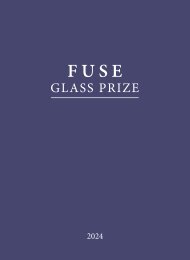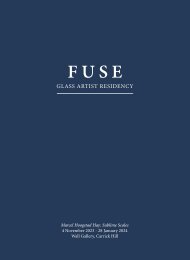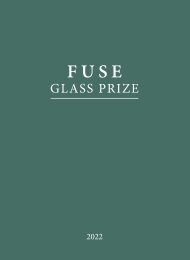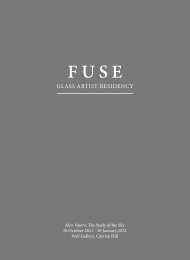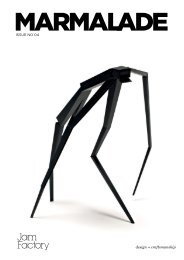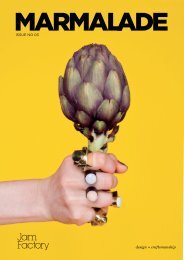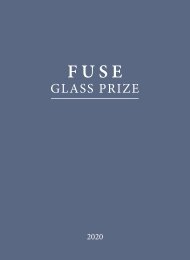Marmalade Issue 5, 2017
Create successful ePaper yourself
Turn your PDF publications into a flip-book with our unique Google optimized e-Paper software.
Launched in 2013, JamFactory’s<br />
annual icon series celebrates the<br />
achievements of South Australia’s<br />
most outstanding and influential<br />
artists working in crafts media.<br />
South Australia’s leading contemporary jeweller and artist<br />
Catherine Truman was selected as JamFactory’s <strong>2017</strong><br />
Icon. Her exhibition no surface holds presents an in-depth<br />
survey of the works produced over the last two decades,<br />
at the nexus of art and science. Through multiple sciencebased<br />
residencies, Truman has cultured many special and<br />
enduring relationships with anatomists, and histologists,<br />
neuroscientists and natural scientists, microscopists and<br />
ophthalmologists. These bonds of trust are at the heart of<br />
many of the works found in the exhibition.<br />
JamFactory’s Senior Curator, Margaret Hancock Davis,<br />
recently caught up with Truman at Gray Street Workshop<br />
to uncover some of the research and thinking behind the<br />
works in this exhibition.<br />
Catherine, your first foray into the science-based residencies<br />
was a broad-based interaction with the scientists and<br />
collection managers at the Museum and Art Gallery of the<br />
Northern Territory in 1997. How did this residency come<br />
about and what did you hope you would experience there?<br />
This was such an important residency and it was a complete<br />
surprise of the best kind. In 1995 Judy Kean, a curator from<br />
the Museum and Art Gallery of the Northern Territory offered<br />
a two-month residency where I was to have free reign,<br />
working with the resources of the museum, including the<br />
staff. When I arrived I remember feeling overwhelmed, not<br />
really having a clue where to begin. It was a complete tabula<br />
rasa – totally new territory, wonderful and awe-inspiring.<br />
I decided the best way in was to meet with as many people<br />
there as I could, and just simply observe, listen and learn.<br />
I do remember asking lots of questions.<br />
I found the scientists to be the most curious of beings, and<br />
spent two months gradually unravelling the amazing parallels<br />
between us. I felt completely at home in their laboratories<br />
learning the rigors of scientific rule. But actually it was the<br />
very human side, the nuanced self-expression I noticed<br />
seeping through the science that got me hooked.<br />
I have read that you are intrigued by the role of intuition,<br />
interpretation and practical human skill plays in the<br />
communication and expression of subject matter in both the<br />
artist studio and scientific research laboratory environments.<br />
Through your residencies you note that the processes of<br />
science and art are not so dissimilar, in what ways is this<br />
the case?<br />
To describe the colour of a shell as a flush of blush pink is<br />
quite evocative, yes? That’s the line I remember reading in a<br />
scientific publication written by one of the scientists I worked<br />
with in Darwin describing one of his favourite molluscs. It led<br />
me to question that if two scientists were describing the very<br />
same species and following all the rules of taxonomy, would<br />
those descriptions be exactly the same? Highly unlikely…<br />
We are all different.<br />
We each have a slightly different slant on the world and we<br />
bring a unique perspective and a unique library of skills to<br />
the ways we attempt to interpret life. I find that concept<br />
both logical and confronting, especially when it comes to<br />
how knowledge is generated about the human body – our<br />
anatomy. Ian Gibbins, neuroscientist, anatomist, poet and<br />
filmmaker, my collaborator of many years says:<br />
Somehow both scientists and artists have a level of self-belief<br />
that drives them to produce new work that they feel the rest<br />
of the world needs to know about. Yet, (good) scientists<br />
and artists alike are driven by self-doubt, uncertainty of<br />
the validity of their directions, having far too many ideas<br />
to effectively pursue at any point in time. In the end, what<br />
keeps both scientists and artists going is the excitement and<br />
challenge of being totally immersed in uncertainty, with just<br />
enough confidence that there is a way out to keep going…<br />
As part of your arts practice you spend time writing. One<br />
of your beautiful pieces of poetry is A Morning’s Anatomy.<br />
Written during the first anatomy class you attended in 2008<br />
with second-year medical anatomy students, the poem is<br />
in many ways a meditation on how you felt or how others<br />
around you may have been responding to your presence in<br />
the room.<br />
I do write a lot. The writing is a grounding strategy, no doubt.<br />
In this instance it was a way of absorbing the fine detail of<br />
the experience – writing this way, without filters is so direct.<br />
I often use this strategy as a way of drawing out an<br />
immediate response to something that seems unfathomable<br />
at first glance. Almost like bypassing the analysis so I can<br />
get to the crux of how I really feel. It’s incredibly personal<br />
and revealing.<br />
This piece of writing in particular helped me deal with the<br />
profound nature of the subject matter in that room that day.<br />
It also acted as a bridge between Ian and myself. I read it<br />
to him later and he said it was the first time he had had his<br />
teaching reflected in such a way. We based a lot of our future<br />
work on the seeds sown that day.<br />
I have been very interested by your observation that<br />
anatomical representations are not a passive representation<br />
of a subject rather they are imbued with the makers or artist<br />
hand, they are individualistic.<br />
I have been fascinated with the history of the representation<br />
of human anatomy for many years. Every representation of<br />
the human body by another human being, an image, a<br />
model, is filtered somehow by someone else’s experience.<br />
The images we carry of the body, of our bodies, are hand<br />
made by others. That thought alone will keep me amused<br />
for a very long time, especially as the technology for imaging<br />
the body develops into the future. We still only glimpse<br />
human anatomy and physiology. The subject is immense and<br />
no one person can claim conclusive knowledge of it, ever.<br />
In recent years you have collaborated with a number of<br />
artists on projects, in particular, the microscopy project<br />
presented at Flinders University Art Museum in 2014. Has<br />
working in a shared space i.e. Gray Street Workshop helped<br />
prepare you for such projects?<br />
ISSUE 05 / 21




